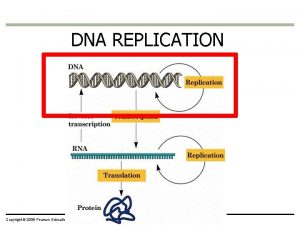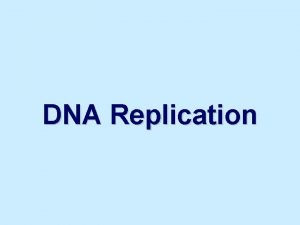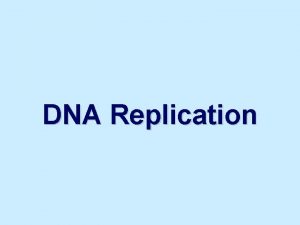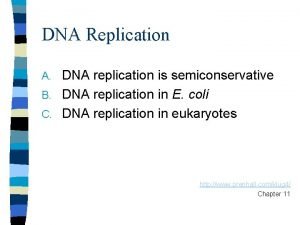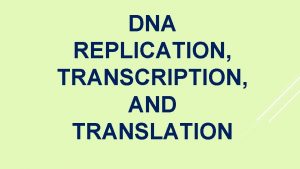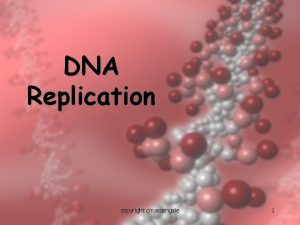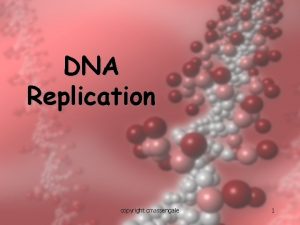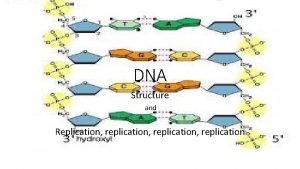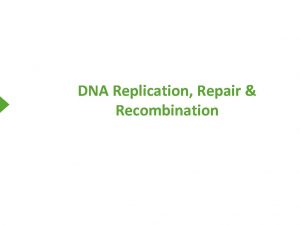1 DNA Replication Copyright 2002 Pearson Education Inc



















- Slides: 19

1

DNA Replication Copyright © 2002 Pearson Education, Inc. , publishing as Benjamin Cummings


DNA replication • When a cell copies a DNA molecule, each strand serves as a template ﻧﻤﻮﺫﺝ for ordering nucleotides into a new complimentary strand ﺍﻟﺠﺎﻧﺐ ﺍﻟﻛ ﻝ. – Nucleotides line up ﺗﺗﺭﺍﺹ along the template strand according to the base-pairing rules. – The nucleotides are linked to form new strands (complementary). 4 Copyright © 2002 Pearson Education, Inc. , publishing as Benjamin Cummings

Types of DNA replication • Semiconservative replication (the most common and accepted by Watson and Crick). The double helix replicates each of the daughter molecules and will have one old strand one newly made strand. • The other two models are the conservative and the dispersive models 5

Semiconservative DNA Replication ﻧـــــﺦ 1. During DNA replication, base pairing ﺇﺯﺩﻭﺍﺝ ﺍﻟﻘﻮﺍﻋﺪ enables existing DNA strands to serve as templates ﻗﺎﻟﺐ / ﻧﻤﻮﺫﺝ for new complimentary strands ﺍﻟﺠﺎﻧﺐ ﺍﻟﻛ ﻝ 2. Several enzymes and other proteins carry out DNA replication: Helicase, Primase, Polymerase, Ligase. The ends of DNA molecules are replicated by a special mechanism.

A large team of enzymes and other proteins carries out DNA replication: The Replication Mechanism • It takes E. coli less than an hour to copy each of the 5 million base pairs in its single chromosome and divide to form two identical daughter cells. • A human cell can copy its 6 billion base pairs and divide into daughter cells in only a few hours. • This process is remarkably accurate, with only one error per billion nucleotides. • A helicase; untwists ﻟﻐﻲ ﺍﻹﻟﺘﻔﺎﻑ and separates the template DNA strands at the replication fork. • Single-strand binding proteins; keep the unpaired template strands apart ﻣﻨﻔﺼﻠﻴﻦ during replication.

The Replication Mechanism • The replication of a DNA molecule begins at special site called origin of replication ﻣـﻨﺸﺄ ﺍﻟﺘﻀﺎﻋﻒ which is a single specific sequence of nucleotides that is recognized by the replication enzymes. • Replication enzymes separate the strands, forming a replication “bubble” ﻓﻘﻌﺔ ﺍﻟﺘﻀﺎﻋﻒ. – Replication proceeds in both directions until the entire molecule is copied. • In eukaryotes, there may be hundreds or thousands of bubbles (each has origin sites for replication) per chromosome. – At the origin sites, the DNA strands separate forming a replication “bubble” with replication forks ﺷﻮﻛﺔ ﺍﻟﻨﺴﺦ at each end. – The replication bubbles elongate ﺗﺴﺘﻄﻴﻞ as the DNA is replicated and eventually fuse ﺗﻨﺪﻣﺞ ﻣﻊ ﺑﻌﻀﻬﺎ.

• Primer: ( ﺑﺪﻳﺀ a short segment of RNA, 10 nucleotides long) is required to start a new chain. • Primase: (an ( RNA polymerase) links ribonucleotides that are complementary to the DNA template into the primer. • DNA polymerases: catalyze the elongation of new DNA at a replication fork. After formation of the primer, DNA polymerases can add deoxyribonucleotides to the 3’ end of the ribonucleotide chain. • Another DNA polymerase later replaces the primer ribonucleotides with deoxyribonucleotides complimentary to the template. 9

Source: http: //highered. mcgraw-hill. com/sites/dl/free/0072437316/120060/ravenanimation. html

The Replication Mechanism • • • DNA polymerases can only add nucleotides to the free 3’ end of a growing DNA strand. A new DNA strand can only elongate in the 5’->3’ direction. At the replication fork, one parental strand (3’-> 5’ into the fork), the leading strand, can be used by polymerases as a template for a continuous complimentary strand. The other parental strand (5’->3’ into ( the fork), the lagging strand, is copied away from the fork in short segments (Okazaki fragments )ﻗﻃﻉ ﺻﻐﻴﺮﺓ. Okazaki fragments (each about 100 -200 ( nucleotides) are joined by DNA ligase ﺍﻹﻧﺰﻳﻢ ﺍﻟﺮﺍﺑﻂ to form the sugar-phosphate backbone of a single DNA strand. 11

Source: http: //highered. mcgraw-hill. com/sites/dl/free/0072437316/120060/ravenanimation. html

Summary of DNA replication mechanism Step 1 • Helicases: Enzymes that separate the DNA strands • Helicase move along the strands and breaks the hydrogen bonds between the complimentary nitrogen bases • Replication Fork: the Y shaped region that results from the separation of the strands Step 2 • • • DNA Polymerase: enzymes that add complimentary nucleotides. Nucleotides are found floating freely inside the nucleus Covalent bonds form between the phosphate group of one nucleotide and the deoxyribose of another • Hydrogen bonds form between the complimentary nitrogen bases Step 3 • DNA polymerases finish replicating the DNA and fall off. • The result is two identical DNA molecules that are ready to move to new cells in cell division. • Semi-Conservative Replication: this type of replication where one strand is from the original molecule and the other strand is new

Summary of DNA replication mechanism • • • Each strand is making its own new strand. DNA synthesis is occurring in two different directions One strand is being made towards the replication fork and the other is being made away from the fork. The strand being made away from the fork has gaps. • Gaps are later joined by another enzyme, DNA ligase • • The strands in the double helix are antiparallel ﻣﺘﻮﺍﺯﻳﻴﻦ ﻭ ﻣﺘﻀﺎﺩﻳﻦ ﻓﻰ ﺍﻹﺗﺠﺎﻩ. The sugar-phosphate backbones run in opposite directions. – Each DNA strand has a 3’ end with a free OH group attached to deoxyribose and a 5’ end with a free phosphate group attached to deoxyribose. – The 5’ -> 3’ direction of one strand runs counter to ﻋﺎﻛﺲ ﻟـ the 3’ -> 5’ direction of the other strand.

Summary of DNA replication mechanism The two DNA-strands separate forming replication bubbles. Each strand functions as a template for synthesizing new complementary & lagging strands via primers, polymerase and ligase. 3 5 T A C T G A C A T G A C T G 3 5 Complementary (leading) strand T A C T G Primer Polymerase Ligase A C 5 3 Lagging strand (complementary) Okazaki fragments Templates


Definitions • Helicase: untwists the double helix to separate the DNA strands by forming replication bubbles. • Replication enzymes: separates DNA strands, forming a replication “bubble”. • Replication bubble: formed at the origin sites of replication as DNA strands separate, and hence, replication forks formed at each end. • Replication site: it is also called origin of replication which is a single specific sequence of nucleotides that is recognized by the replication enzymes and at which replication starts. • Primer: is a short piece of RNA (10 nucleotide long) which is synthesised by primase and used to initiate the leading strands of the new DNA. • DNA-polymerase: builds up the new DNA strand by adding nucleotides to the primer (from 5’ to 3’ end). • Leading strand: the elongation strand (5’ 3’ into the fork) that initiate the new DNA after recognizing the sequence of the primer by special proteins. • Lagging strand: Is the other parental strand (5’ 3’ into the fork), is copied away from the fork in short segments (Okazaki fragments). • Okazaki fragments: the newly formed segments (5’ 3’, away from the fork) then, form the lagging strand when connected by ligase towards the fork. • DNA-ligase: joins the Okazaki fragments of the newly formed bases to form the new lagging DNA strand.


College of Science, Zoology Department General Animal Biology (Zoo-145) Prof. Ashraf M. Ahmed aalii@ksu. edu. sa
 Bioflix activity dna replication nucleotide pairing
Bioflix activity dna replication nucleotide pairing 2017 pearson education inc
2017 pearson education inc Copyright pearson education inc
Copyright pearson education inc Copyright 2010 pearson education inc
Copyright 2010 pearson education inc 2009 pearson education inc
2009 pearson education inc Copyright pearson education inc
Copyright pearson education inc Copyright 2014 pearson education inc
Copyright 2014 pearson education inc Copyright 2010 pearson education inc
Copyright 2010 pearson education inc Copyright 2010 pearson education inc
Copyright 2010 pearson education inc Copyright by pearson education inc. answers
Copyright by pearson education inc. answers Copyright 2003 pearson education inc
Copyright 2003 pearson education inc Copyright 2009 pearson education inc
Copyright 2009 pearson education inc 2015 pearson education inc
2015 pearson education inc Copyright 2010 pearson education inc
Copyright 2010 pearson education inc Copyright 2010 pearson education inc
Copyright 2010 pearson education inc Copyright 2010 pearson education inc
Copyright 2010 pearson education inc Copyright 2010 pearson education inc
Copyright 2010 pearson education inc Copyright 2010 pearson education inc
Copyright 2010 pearson education inc Composition copyright example
Composition copyright example Pearson education inc all rights reserved
Pearson education inc all rights reserved


























